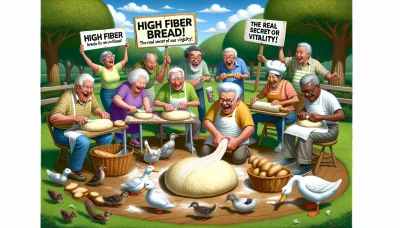High fiber foods for toddlers Quiz
Test Your Knowledge
Question of
Understanding the Importance of Fiber for Toddlers
Health Benefits of High Fiber Foods
Introducing high fiber foods into a toddler's diet can be a game changer for their health. These nutrient powerhouses support a growing body in numerous ways, from improving bowel movements to reducing the risk of chronic diseases later in life. It's like giving your child's health an incredible head start!
Fiber-rich foods are not just about keeping things moving; they're also about laying the foundation for a robust digestive system. They help maintain a healthy weight by providing a feeling of fullness, which prevents overeating. It's an all-around win for your little one's well-being!
Boosting Digestive Health in Toddlers
Imagine a tiny superhero fighting off digestive woes! That's what fiber does for toddlersit keeps their digestive systems running smoothly. By increasing stool bulk and frequency, fiber helps prevent constipation, which is crucial for toddlers as they explore new foods.
A toddler with a happy gut is a happy toddler overall. A diet rich in fiber can help set the stage for lifelong digestive health, ensuring that your child absorbs all the necessary nutrients from their adventurous meals.
Strengthening Immune Function in Young Children
Fiber does more than you think! It plays an essential role in bolstering the immune system of young children. Fiber acts as a prebiotic, providing nourishment for beneficial gut bacteria which are integral to immune defense.
This means that with every fiber-filled snack, your toddler is building an army of good bacteria to protect them against pesky pathogens. It's like equipping them with an invisible shield against illnesses!
Daily Fiber Requirements for Toddlers
When it comes to fiber intake, toddlers have specific needs that differ from adults. It's important to hit that sweet spotnot too little and not too muchto ensure optimal health benefits without causing any tummy troubles.
The American Academy of Pediatrics has guidelines suggesting that children should consume an amount of fiber equivalent to their age plus five grams daily. This simple formula provides a great starting point for parents to plan balanced meals.
Age-Appropriate Fiber Intake Guidelines
Paying attention to age-appropriate fiber intake is critical because toddlers' digestive systems are still developing. Providing the right amount of fiber can support healthy growth and development without overwhelming their delicate systems.
Familiarizing yourself with the various sources of dietary fiber will empower you to create diverse and delicious menus that keep your toddler both happy and healthy.
Signs of Adequate Fiber Consumption
- Regular Bowel Movements: A clear sign that your toddler is getting enough fiber is regular, soft bowel movements.
- Satiety Between Meals: If your child remains satisfied between meals without needing constant snacks, it may indicate sufficient fiber intake.
- Few Digestive Complaints: A lack of digestive issues such as bloating or gas can also suggest adequate dietary fiber consumption.
- Energetic Behavior: Adequate fiber contributes to overall well-being, often reflected in your child's energy levels and mood.
Identifying High Fiber Foods Suitable for Toddlers
Natural Sources of Fiber for a Toddler's Diet
When it comes to boosting your toddler's fiber intake, natural is the way to go! Fresh fruits and veggies are not only loaded with essential vitamins and minerals but also packed with dietary fiber. This fiber aids digestion and keeps things moving smoothly in your little one's tummy. Think apples with the skin on, ripe pears, and even delightful berries they're all toddler-friendly and utterly nutritious!
Don't forget the powerhouses like sweet potatoes, carrots, and peas! These vibrant veggies are not just visually appealing to curious toddlers but are brimming with fiber. And when it comes to legumes, lentils, and beans, they're a fantastic source of both protein and fiber, making them an excellent choice for your growing child's diet.
Fruits and Vegetables Rich in Fiber
Fruits such as raspberries, pears, and apples (with the skin) are top-notch choices when picking high-fiber foods for your tot. Vegetables like broccoli, green peas, and carrots can be steamed to a soft consistency perfect for those tiny teeth. It's crucial to ensure these foods are prepared safely to prevent choking hazards while still preserving their fibrous benefits.
Whole Grains and Legumes for Toddlers
Whole grains are a hidden gem in the world of toddler nutrition. Items like oatmeal, brown rice, and whole-grain breads offer a robust boost of fiber that is essential for healthy digestion. And when we talk about legumes chickpeas, black beans, and lentils you're looking at a winning combo of fiber and protein that supports your toddler's growth in every spoonful!
Creative Ways to Incorporate Fiber into Toddler Meals
Getting creative with mealtime can turn the challenge of feeding toddlers into an exciting adventure! Blend some high-fiber fruits into smoothies or mix them into yogurt for a tasty treat. Or how about making mini muffins? By using whole-grain flour or oats, you can bake up a batch of fun-sized snacks that are not only adorable but also packed with fibrous goodness.
- Mix it up: Add pureed vegetables into sauces or stews to seamlessly increase fiber content.
- Spread the love: Use hummus or bean spreads on sandwiches or crackers for a kid-friendly fiber hit.
- Sneaky chef: Incorporate grated veggies like zucchini or carrots into pasta dishes or meatballs.
- Dip it: Create colorful veggie platters with tasty dips to encourage raw veggie snacking.
- Bake smart: Substitute white flour with whole wheat flour in baking recipes for an added fiber boost.
- Cereal switch: Choose high-fiber cereals over sugary options for a healthier breakfast choice.
Fiber-Filled Snacks for On-the-Go
The hustle and bustle of daily life mean snack time needs to be quick yet nutritious. Opting for portable snacks like whole-grain crackers paired with cheese or apple slices with peanut butter offers both convenience and a punch of dietary fiber. These easy-to-pack options ensure your toddler gets their fiber fix even when youre out and about!
Fun and Tasty High Fiber Recipes for Kids
Cooking up fibrous meals that delight those picky palates is easier than you think! Whip up some whole grain pancakes dotted with blueberries on Sunday mornings or craft adorable sandwiches using high-fiber bread cut into playful shapes. Its all about making fiber-rich foods irresistible to little eyesand taste buds!
Balancing a Toddler's Diet with Adequate Fiber
The Role of Fiber in a Balanced Toddler Diet
Fiber is a powerhouse nutrient that keeps toddlers' digestive systems running smoothly. It helps prevent constipation, which is common in young children, and also contributes to overall gut health. But here's the kicker: it's not just about digestion. Fiber-rich foods are often packed with essential vitamins and minerals, making them an all-star component in any toddler's diet.
It's crucial to start early! Introducing fiber into your toddler's diet sets the stage for healthy eating habits that last a lifetime. But remember, balance is key. While fiber is important, it should be incorporated alongside proteins, fats, and carbohydrates to ensure a well-rounded diet. Don't go overboard; too much fiber can be overwhelming for tiny tummies.
Combining Fiber with Other Essential Nutrients
When it comes to toddlers, think of their plates as a canvas for nutrition. A splash of fiber here, a dab of protein therevoila! You've got a masterpiece of health. Whole grains, fruits, and vegetables are your best friends; they bring fiber to the party along with a host of other nutrients like iron and antioxidants.
Let's get practical: pair that whole wheat pasta with some lean chicken and broccoli or top that oatmeal with slices of banana. These combinations are not only nutritious but also keep those little energy tanks full and ready for playtime. And guess what? They're naturally colorful, making them visually appealing to discerning toddler eyes.
Portion Control and Meal Planning for Toddlers
Portion control is like the volume knob on mealtimeit ensures your toddler isn't overloaded with too much of even the good stuff. Small, manageable servings of high-fiber foods encourage them to try new flavors without feeling overwhelmed. This approach avoids waste and teaches them about moderation from an early age.
Planning ahead can be your secret weapon against the chaos of feeding a toddler. Create a weekly menu that includes various fiber sources like lentils, beans, and peas. These meal plans don't just ease your daily stress; they also provide consistent opportunities for your child to experience different textures and tastes.
Overcoming Challenges with Picky Eaters
Picky eaters can turn mealtime into a battleground, but don't raise the white flag just yet! Persistence is key when introducing new high-fiber foods. It may take several attempts before your little one warms up to the idea of munching on some carrot sticks or taking that first bite of quinoa.
Remember that toddlers learn by example. If they see you enjoying a variety of foods, they're more likely to follow suit. Keep mealtimes positive and stress-free; this isn't the time for lectures on nutritionlet their curiosity lead the way instead.
Introducing New Foods to Reluctant Toddlers
New foods can be scary territory for toddlersit's unfamiliar terrain! But don't worry; patience is your ally here. Introduce new foods alongside old favorites so they have something comfortable to fall back on. This mix-and-match strategy reduces pressure and invites exploration in small steps.
- Mix it Up: Blend high-fiber foods with familiar favorites to make them less intimidating.
- Get Creative: Use cookie cutters or fun shapes to make fiber-rich foods more visually enticing.
- Involve Them: Let toddlers help prepare meals; they're more likely to eat what they've had a hand in making.
- Be Consistent: Regularly offer new options without making a big fuss if they're initially rejected.
- Praise Adventurous Eating: Positive reinforcement can work wonders when they try something new.
- Educate Through Storytelling: Use stories about food to spark interest in trying new things.
- Avoid Force-Feeding: Always let your child decide if they want to eat the new food or not.
- Foster Independence: Offer choices within limits so they feel in control of their eating experience.
Tips for Making High Fiber Foods More Appealing
To win over those picky eaters, presentation matters! Make high-fiber foods irresistible by incorporating them into smoothies or baking them into muffinssneaky yet effective tactics. The goal is not deception but rather showing how delicious fiber can be in various forms.
Leverage natural sweetnessfruits like apples or pears can sweeten the deal when mixed into oatmeal or yogurt. And let's not forget dips! Hummus or yogurt-based dips can make raw veggies more tempting for those skeptical taste buds. The trick is to keep experimenting; you'll find that winning combination that makes your toddler reach for more!
Managing and Preventing Constipation in Toddlers
Dietary Adjustments to Alleviate Constipation
Transforming your toddler's diet can be a game-changer in battling constipation. Integrating fiber-rich fruits, vegetables, and whole grains can significantly improve bowel movements. Remember, changes should be gradual to allow the child's digestive system to adapt seamlessly.
Portion control is key; too much fiber can be counterproductive, causing gas or bloating. A balanced diet that includes a variety of nutrients will not only ease constipation but also contribute to overall health. Keep meals regular, consistent, and pay attention to your toddler's appetite cues.
High Fiber Foods that Help with Regularity
Incorporating high-fiber foods into your toddler's diet is essential for maintaining regularity. Start with oatmeal for breakfast, offer slices of apple for snacks, and add peas or carrots to their lunch and dinner plates. These foods have the kind of fiber that sweeps through the intestines, easing constipation.
Avoid over-reliance on high-fiber foods as they could cause discomfort if not balanced with other food groups. It's all about finding that sweet spot where the diet promotes regular bowel movements without leading to other issues.
Hydration and Its Role in Digestive Health
Liquid gold water! Hydration is often underestimated when it comes to digestive health. Encourage your toddler to drink plenty of fluids throughout the day. Water helps soften stools, making them easier to pass.
Milk can be a double-edged sword; while it provides calcium crucial for growing bodies, excessive intake may lead to constipation in some toddlers. Monitor milk consumption and consider offering water or diluted fruit juices as alternatives throughout the day.
When to Seek Medical Advice for Toddler Constipation
Knowing when to seek medical advice is crucial. If simple dietary adjustments don't resolve your toddler's constipation or if it recurs frequently, it may be time to consult a pediatrician. Persistent constipation could be a sign of an underlying condition that needs professional attention.
Don't hesitate if you notice symptoms such as abdominal pain, blood in the stool, or if your child exhibits behavioral changes like avoiding bathroom visits due to pain. These are clear signals that professional medical advice is needed.
Recognizing the Signs of Chronic Constipation
- Infrequent Bowel Movements: Less than three per week could indicate a problem.
- Hard Stools: Small, hard pellets are a common sign of constipation.
- Painful Defecation: If your child expresses pain during bowel movements, take note.
- Bloating: A bloated abdomen can sometimes accompany chronic constipation.
- Lack of Appetite: Chronic constipation might reduce your toddler's desire to eat.
- Fatigue: Overall weariness could be related to the body's strained efforts to defecate.
Consulting Healthcare Providers for Dietary Changes
If you suspect chronic constipation in your toddler, make an appointment with a healthcare provider before making significant dietary changes. They can provide tailored advice that considers any unique health concerns or nutritional needs your child may have.
A healthcare provider might suggest specific supplements or medications alongside dietary adjustments. It's imperative to follow their guidance closely and report back on your childs progress regularly for ongoing support and advice.
Allergies and Sensitivities to High Fiber Foods in Toddlers
Identifying Food Allergies and Intolerances
Understanding the difference between food allergies and intolerances is critical when it comes to managing your toddler's diet. Allergies involve the immune system and can lead to serious reactions, while intolerances are generally less severe and often related to digestion. It's essential to observe any adverse reactions your toddler may have after consuming high fiber foods.
Consulting with a pediatrician is the first step in identifying potential food allergies or intolerances. They can provide guidance based on your child's symptoms and dietary history. Keeping a detailed food diary for your toddler can help pinpoint problematic foods. Remember, early detection is key to managing symptoms and ensuring your child's well-being.
Common Symptoms of Food Allergies in Children
Symptoms of food allergies in toddlers can range from mild to severe, including hives, itching, swelling, digestive distress, and in extreme cases, anaphylaxis. It's vital to monitor for any unusual signs after meal times, such as excessive fussiness or changes in skin condition. Immediate medical attention is required if breathing difficulties or swelling of the face occurs.
The Process of Allergy Testing for Toddlers
Allergy testing for toddlers involves either a blood test or a skin prick test. These tests are designed to identify specific allergens that trigger reactions. Your pediatrician will advise on the most appropriate test based on your childs age and condition. Following proper diagnosis, an effective management plan can be developed.
Safe Alternatives for Toddlers with Dietary Restrictions
Finding safe and nutritious alternatives for toddlers with high fiber food sensitivities demands creativity and careful planning. Its important to replace fiber sources with equally nutritious options that wont trigger allergic reactions or intolerances. Consulting with a dietitian can provide tailored recommendations that suit your toddler's dietary needs.
Finding Fiber Sources for Sensitive Tummies
- Select fruits like bananas and applesauce which are gentler on the stomach.
- Incorporate cooked vegetables such as carrots and squash that are easier to digest.
- Choose grains like oatmeal or rice cereal that are less likely to cause discomfort.
- Consider using peeled fruits and vegetables as peeling can remove some of the fibers that may cause issues.
- Hydration is crucial; ensure adequate fluid intake to help manage fiber digestion.
Adapting Meals for Toddlers with Food Allergies
Crafting meals for toddlers with food allergies doesn't have to be daunting. Start by swapping out ingredients that cause problems with hypoallergenic options. For instance, use gluten-free flours instead of wheat flour if gluten is an issue. Always read labels carefully as allergens can hide in unexpected places.
Educate everyone involved in your toddlers care about their dietary restrictions. This includes family members, daycare providers, and teachers. Ensuring they understand what foods must be avoided helps prevent accidental exposure and keeps your toddler safe.
Educational Activities to Teach Toddlers About Healthy Eating
Fun and Interactive Ways to Learn About Fiber
Introducing toddlers to the concept of fiber can be a blast with creative activities that stimulate their curiosity. Turn nutrition into a game by creating colorful charts that track their daily fiber intake. This visual approach not only educates but also excites them about healthy eating habits.
Puppets and role-play scenarios are fantastic tools for teaching toddlers about the benefits of fiber. Using these playful methods, you can weave stories about how fiber helps with digestion and keeps us strong, making the learning process both engaging and memorable.
Storybooks and Games Focused on Nutrition
Storybooks with vibrant illustrations capture the imagination of young minds, making them a perfect medium for lessons on nutrition. Look for books that feature characters embarking on adventures powered by healthy, high-fiber foods. These tales make the connection between good food and energy tangible for toddlers.
Board games and interactive apps designed with nutrition in mind serve as excellent educational platforms. They introduce concepts like food groups and balanced diets in an entertaining format. These games often include challenges that reinforce the importance of making smart food choices.
Cooking Together: A Hands-On Approach to Learning
Engaging toddlers in cooking is a hands-on way to teach them about healthy eating. Preparing simple snacks rich in fiber, like fruit kebabs or vegetable dips, allows them to see and taste what they've made. This direct involvement boosts their interest in nutritious foods.
While cooking, discuss the ingredients' health benefits, emphasizing how each component contributes to their well-being. This dialogue fosters an understanding of nutrition that goes beyond just following recipes, instilling knowledge they can apply throughout their lives.
Involving Toddlers in Meal Preparation and Grocery Shopping
Taking toddlers along for grocery shopping opens up opportunities to teach them about healthy food choices. Encourage them to pick out high-fiber fruits and vegetables, turning it into a game of colors and shapes. This interaction makes grocery shopping an educational experience rather than a chore.
- Start with Colors: Ask your toddler to find fruits and veggies in every color of the rainbow.
- Texture Time: Let them touch and feel different produce items to understand texture differences.
- Snack Picks: Have your toddler help choose whole-grain snacks or cereals, reinforcing the idea of 'smart snacks'.
- Name Game: Encourage learning names of new fruits or vegetables, expanding their vocabulary along with their nutritional knowledge.
- Nutrition Numbers: Introduce basic numbers by counting pieces of fruit or vegetable servings they put in the cart.
Including young children in meal prep is not only fun but also educational. Assign simple tasks such as washing fruits or tearing lettuce for salads. These activities make them feel involved and more likely to eat what they've helped prepare, especially when it's packed with fiber!
Monitoring Your Toddler's Progress and Making Adjustments
Keeping a Food Diary to Track Fiber Intake
Starting a food diary for your toddler is an exhilarating journey towards health! It's a powerful tool that captures every delicious bite of their high-fiber adventure. This log not only tracks what your little one eats but also when and how much, giving you a comprehensive view of their dietary patterns. Get ready to turn the page on your childs nutrition with each entry!
Imagine the thrill of flipping through your toddler's food diary and spotting trends and habits like a dietary detective! You'll see which high-fiber champions are their favorites and which ones they might shy away from. It's a hands-on way to ensure they're getting the right balance of fruits, veggies, grains, and legumes. Keep it up, and you'll be building a foundation for lifelong healthy eating habits!
The Benefits of Recording Meals and Snacks
Hold onto your hats because recording meals and snacks is like having a superpower for boosting your toddler's health! Every scribble in the food diary brings clarity to their diet, helping you pinpoint exactly where to sprinkle in more fiber-rich foods. It's not just about quantity; it's about quality too. With this mighty log in hand, you're set to optimize their intake for vibrant growth!
And here's the kicker maintaining this diary isn't just good for now; it sets the stage for future success! You're teaching your toddler about awareness and choices that lead to robust health. Plus, you can share this goldmine of information with healthcare professionals who can offer tailored advice based on real-life data. Talk about teamwork for your little ones well-being!
When to Update Your Toddler's High Fiber Diet Plan
Just when you think you've got it all figured out, toddlers throw a curveball with their growth spurts! These rapid changes are your cue to reassess their high-fiber diet plan. As they grow taller and more active, their energy needs soar. Be ready to adjust portions or introduce new fiber-packed powerhouses to keep up with their growing bodies.
Your childs development is a dynamic wonder, full of twists and turns! Their tastes evolve, so revisiting dietary choices is key. It's not just about adding more fiber; it's about ensuring variety for a rainbow of nutrients. Stay alert to these changes they're opportunities to teach them about healthy eating while tailoring their diet to meet their bodys demands.
- Growth Spurts: Increase fiber-rich foods during growth spurts as energy needs increase.
- New Foods: Introduce new fiber sources regularly to encourage variety.
- Taste Preferences: Adapt the diet plan based on your toddlers evolving tastes.
- Nutritional Balance: Ensure that increased fiber does not replace other essential nutrients.
- Regular Reviews: Reassess the diet plan periodically or after significant milestones.
- Professional Input: Consult healthcare providers for personalized dietary adjustments.
- Educational Moments: Use dietary updates as chances to educate on nutrition.












